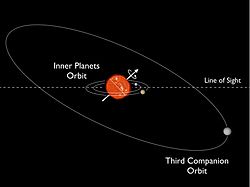Top Qs
Timeline
Chat
Perspective
Kepler-56
Red giant star in the constellation Cygnus From Wikipedia, the free encyclopedia
Remove ads
Kepler-56 is a red giant[8] in constellation Cygnus roughly 3,030 light-years (930 pc) away[2] with slightly more mass than the Sun.
Remove ads
Characteristics
Kepler-56 is a red giant star. This means it is no longer fusing hydrogen in its core and is off the main sequence. Its mass is around 1.3 M⊙. Its radius is about 4.2 R⊙, putting the star's density at about 0.025 g/cm3. For reference, the Sun's density is about 1.408 g/cm3. Its metallicity is about 0.0251 Z0/X0. Its luminosity is about 9.6 L⊙, and its effective temperature is 4,973 K (4,700 °C; 8,492 °F).[4]
Kepler-56 is about 3.9 billion years old,[4] placing it as about 600 million years younger than the Sun. Its apparent magnitude is +13, making it too dim to be visible to the naked eye.
Remove ads
Planetary system
In 2012, scientists discovered a two-planet planetary system around Kepler-56 via the transit method. Asteroseismological studies revealed that the orbits of Kepler-56b and Kepler-56c are coplanar but about 45° misaligned to the host star's equator. In addition, follow-up radial velocity measurements showed evidence of a gravitational perturbator.[8] It was confirmed in 2016 the perturbations are caused by third, non-transiting planet: Kepler-56d.[9]
The planetary system is very compact but is dynamically stable.[10]
Kepler-56 is expanding. As a result, it will devour Kepler-56b and Kepler-56c in 130 and 155 million years, respectively.[11][12] 56d will be far enough to survive its parent star's red giant phase.
Remove ads
References
External links
Wikiwand - on
Seamless Wikipedia browsing. On steroids.
Remove ads

